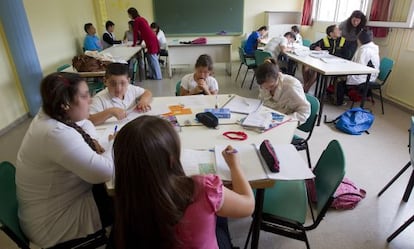750,000 ways of being Gypsy
Spain's Roma community is finding new ways to express its cultural traditions It is managing to increase diversity, while steering clear of clichés Women have emerged as the driving force behind a focus on the importance of education

Antonia Núñez, a 25-year-old Gypsy woman from Benarrabás, Málaga province, remembers something that her mother used to tell her when she was about to complete her high school studies: "If you have to repeat a year, that's OK; you go ahead and repeat." But she passed her examinations, enrolled in Physical Education, and when she got her diploma she went on to university, where she studied to be a social worker. Antonia thus became the first member of her family with higher studies, and a source of pride for her mother, who had once been afraid to let her daughter leave their village of 600 people and move into a shared student apartment in Seville. "Now I am the apple of my parents' eyes, and a role model for my younger cousins," she admits.
Like many other Roma women, Antonia has had to break down barriers to get where she is today. She is at the helm of a slow but constant evolution that some observers are comparing with the changes that non-Gypsy women experienced during Spain's democratic transition in the late 1970s and early 1980s.
"The change is similar, but it is coming later," says Isidro Rodríguez, general director of Fundación Secretariado Gitano (FSG), a foundation that seeks the full integration of the Roma community into society. This transformation, especially with regard to Gypsy women, is more visible now but Rodríguez holds that the process began years ago. "Spain's Gypsy society has changed a lot. But society in general hasn't found that out yet."
Now I am the apple of my parents' eyes, and a role model for my cousins"
Although there is no official census of Spanish Roma people, the latest study by FSG, conducted in 2011, talks about around 750,000 individuals, of whom nearly half (48.8 percent) are under 25. The average age is 28, compared with 41.3 for the general population. It is therefore a young community that grew up with the welfare state and had a chance to enter the education system. And this has been the key to Roma evolution in recent years.
"In the mid-1980s there were practically no Gypsies in school. Today, nearly 100 percent of children finish elementary school," says the foundation director. The figures get worse in secondary education: 80 percent of Roma boys and girls who start high school drop out before getting their diploma. "That's where we all got caught resting on our laurels. It's one of our concerns," admits Rodríguez.
Figures also show that Roma women face more hurdles to access secondary education. The percentage of Gypsy boys in their freshman year is much higher (60.77 percent) than females (39.3 percent).
Some compare this with the changes non-Gypsy women experienced earlier
"We need to break down the barriers little by little," says Antonia Núñez, the social worker who arrived in Seville from a tiny village in Málaga. It took her months to convince her parents that she wanted to keep on studying and move to a big city, and that furthermore she was not going to get married anytime soon, and definitely not with her first boyfriend.
Tamara Amador went through all that a decade ago, although her sister, who is 14 years older, had partly paved the way for her. Tamara was taken out of school early so she could take care of the house. But, unbeknown to her parents, she signed up for vocational training in administrative studies. Her father eventually found out and decided to let her finish.
Young and increasingly educated
- There is no census of the Spanish Gypsy population, but the Fundación del Secretariado Gitano figures that this community numbered around 750,000 in 2011. Nearly half (48.8 percent) are between 0 and 24 years old. The average age is 28.1 versus 41.3 for the general population.
- Seventy percent of Gypsies over the age of 16 are illiterate. But a 2010 study shows 93.2 percent of children aged three to 12 are in school. The figures are worse for secondary education, where the dropout rate is 80 percent.
- In 2011, 77.5 percent of Gypsy students did not miss class over long periods, compared with 43 percent in 1994.
- According to official job figures for the second quarter of 2011, 36.4 percent of Gypsies were out of a job, compared with a jobless rate of 20 percent for the general population at that time.
- In 1978, 75 percent of Roma families lived in substandard housing. Today that percentage has dropped to 12 percent. Around four percent live in shantytowns.
"That changed everything. He was very closed-minded about studying, especially when it came to women. But in the end it was him who was on top of me - I was a very bad student - to make sure I completed my studies," recalls Tamara, now 31. Her parents, who are street vendors, would sometimes drive by the school in their van to make sure that she was in class.
Antonia and Tamara now share an apartment and a workplace: they both have jobs at the Andalusian federation of Gypsy women, Fakali. They are single and say they feel no particular pressure to get married. "I suppose we get the same pressure a non-Gypsy girl might feel. They ask you whether you have a boyfriend, that's all," notes Tamara.
In their jobs, they are realizing that many women of their age who got married in their teens now want their own daughters to take things slower. "Most of the mothers we deal with are very young," says Tamara. "They already know what it's like to marry early and have their own lives cut short. They are the ones telling their daughters not to get married. Often enough the teenagers are more old-fashioned than their own mothers, who are in despair when they hear their girls say that they want to get married now. But there are girls who like to act older, and if they see their 20-year-old friend getting married, they want to do the same."
Despite the pervasive stereotypes about the Gypsies, the numbers and the testimonies show that Spain's Roma population is very heterogeneous. And this trend appears to be getting stronger.
"Spain doesn't have a million Gypsies; there are one million Spaniards who are Gypsy. It's an important nuance," warns Joaquín Bustamante, director of a publication called Cuadernos Gitanos and host of a radio show, Gitanos, arte y cultura romaní, which airs on state radio's multilingual international platform. This diversity makes sense: such a numerous community cannot be homogeneous, notes Bustamante. "There are different beliefs, religions, ideologies, professions and types of training," he says.
What they all share, those who were consulted by this newspaper agree, is a deep sense of belonging to the Roma community. And a sense of pride. "You don't lose that. On the contrary," says Bustamante. "The fear that schooling might take Gypsies' identity away works out the opposite way: education gives you more intellectual tools to better understand your own history and culture - and to defend them."
Spain's Gypsies have changed a lot. But society doesn't know it yet"
The evolution of the Roma population in the last 30 years has brought about new viewpoints on what it's like to be a Gypsy. This cultural change has largely been wrought by the improvement in living conditions. "Spain developed an inclusion model that has worked well," asserts Isidro Rodríguez, of FSG. "The welfare state got to Spain late, but when it did, it embraced everyone. When universal education and healthcare came around, it was also there for the Gypsies. And subsidized housing, and pensions..."
In 1978, 75 percent of Roma families lived in substandard housing. These days, only four percent live in shantytowns, and 12 percent in tenements. "This means living side by side with non-Gypsies, having access to resources and a chance at a greater diversity of jobs," says Rodríguez.
There are still challenges up ahead. Foremost among these, says the head of FSG, is the incorporation of Gypsies into the world of wage-earners. While over 85 percent of working Spaniards are employees, that rate falls to 36 percent among working Roma, most of whom are self-employed. Also, among those Gypsies who do have paid jobs, many are temporary workers: the rate is twice as high as for the general worker population, or 53.4 percent compared with 25.5 percent, according to an FSG study based on 2011 second-quarter official employment figures.
I was a very bad student and in the end it was my dad who pushed me"
For most families, the changes of the last few years have meant facing up to "contradictions," a similar process to what non-Gypsy Spanish families went through three decades ago. "In general the situation is similar, but we need to make a more rigorous analysis," says Joaquín Bustamante. The challenge for the Roma, both young and old, is to adapt traditional values to modern society. "Our traditional values are good and they are the basis of Gypsiness: solidarity, respect for one's elders and helping each other out. We cannot lose that," Bustamante stresses.
But fear that those values might get contaminated have significantly conditioned the evolution of Gypsy culture. "It's a fear that used to exist, but it is disappearing," asserts Isidro Rodríguez. "In Spain it has been proven that things can be compatible. Customs and traditions change to adapt to the times. You do not lose your Gypsy identity because there were traditions that your parents used to follow which you don't," says the FSG director, recalling how a few decades ago, "it wasn't Gypsy" to go to university or for girls to have jobs. Now it is.
Sara Giménez, a lawyer from Huesca who is in charge of the equality department at FSG, had first-hand experience with that parental fear that letting a daughter come into contact with the rest of society at university would pull her away from her roots.
People used to fear our values would be contaminated, but that is disappearing"
"I was dealing with two discourses at home: the social majority and my teachers, who told me to study, and my family, who were afraid; their thinking went something like 'what if studying means she stops being a Gypsy?'," remembers this 35-year-old attorney, the third of four siblings and the only member of her family with a university degree. "We all got the same chances, but I'm the one who stretched out my arm to catch them."
In the year 2000, Sara Giménez became the first Gypsy woman from the Aragon region to get a degree in law. She is convinced that Roma women are the ones spearheading "the great advance" of the Gypsy people, even though they still face "multiple forms of discrimination."
"Gypsy society is very patriarchal, and in society as a whole we face the added difficulty of being Roma. The difficulties are enormous, but Gypsy women are demonstrating more drive - they are the ones who find the strength to pull the whole family through," says Giménez.
We get the same pressure as other girls; they ask if you have a boyfriend"
Besides this gradual incorporation into education and jobs, marriage is being postponed and women are having fewer children, in tune with the rest of Spanish society. "Education has been key to this," says Bustamante. "The Roma population is very young, so we have a future. What we need to do is to prepare these boys and girls to be competitive."
This is what María Sánchez, Pedro Nieves and Domingo Jiménez want for their children. All three of them live in Seville's Polígono Sur, one of the most rundown parts of town, and home to a large Roma population. During the last school year, all three took their children to a program called Promociona, run by FSG, which works with elementary and high school students to make sure they don't drop out. Tutors help with school subject matter, provide counseling for future career choices and, most of all, show them that there are many more roads ahead of them than what they see around them every day.
"It's about creating positive references for them. That's extremely important," explains Fátima Narbona, one of the program workers. The kids all want to study, their parents want them to study, and they go to class every day. "We accept kids with troubled backgrounds and support them so they can complete their studies. Eighty percent of our students make it. There are families where these are the first members to embrace official education and dream of going to college. It is essential to provide the motivation, and to make them feel that studying does not mean losing their identity," she adds.
Only four percent live in shantytowns, down from 75 percent in 1978
Antonia Núñez and Tamara Amador, the roommates and co-workers at Fakali, are aware that they are role models for their younger relatives, and it gives them a sense of pride as well as responsibility. "When my cousins found out I was going to Seville, they thought I'd gotten married. It didn't occur to them that I would leave the village to study. But now they see me and the little ones say they want to do the same," says Antonia.
Rocío Delgado, a 38-year-old intercultural mediator at FSG, is trying to exert the same kind of positive influence inside her own home. She married at age 15, separated from her husband a decade ago, and is a positive role model for her three children. The eldest, who is 18, is studying to be a hairdresser and the 11-year-old twins have just finished fifth grade. "I tell my kids about my own experience so they can learn from it. I don't want them to marry so young; I would rather see them study, live and fight," she says.
Rocío considers herself part of the "invisible Gypsies." "People only talk about the ones who follow the ancient traditions. Or about the flamenco crowd. But in between there's all the rest of us, and we are growing in number."
People are always looking for the stereotypes and not the truth"
This invisible majority was indignant earlier this year with a documentary series that premiered on the Cuatro network, called Palabra de gitano (Gypsy's word). Critics say that it only showed the most stereotypical side of Spanish Gypsies. The parents of Polígono Sur in Seville are weary of seeing their neighborhood in the news only for crime reports, or to illustrate the simplest, most typical image of the Roma.
"When they come shoot a documentary here, they always get the candles and the people dancing around them. Nobody comes at seven in the morning when the bus stops are full of people going to work," laments Pedro Nieves. "People are always looking for the stereotypes about the Gypsies, not the truth."
Tu suscripción se está usando en otro dispositivo
¿Quieres añadir otro usuario a tu suscripción?
Si continúas leyendo en este dispositivo, no se podrá leer en el otro.
FlechaTu suscripción se está usando en otro dispositivo y solo puedes acceder a EL PAÍS desde un dispositivo a la vez.
Si quieres compartir tu cuenta, cambia tu suscripción a la modalidad Premium, así podrás añadir otro usuario. Cada uno accederá con su propia cuenta de email, lo que os permitirá personalizar vuestra experiencia en EL PAÍS.
En el caso de no saber quién está usando tu cuenta, te recomendamos cambiar tu contraseña aquí.
Si decides continuar compartiendo tu cuenta, este mensaje se mostrará en tu dispositivo y en el de la otra persona que está usando tu cuenta de forma indefinida, afectando a tu experiencia de lectura. Puedes consultar aquí los términos y condiciones de la suscripción digital.








































